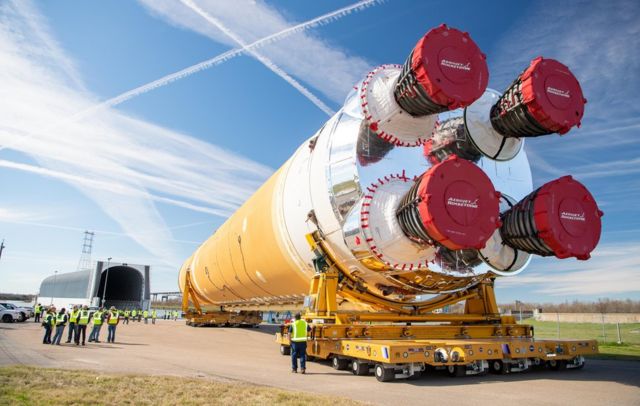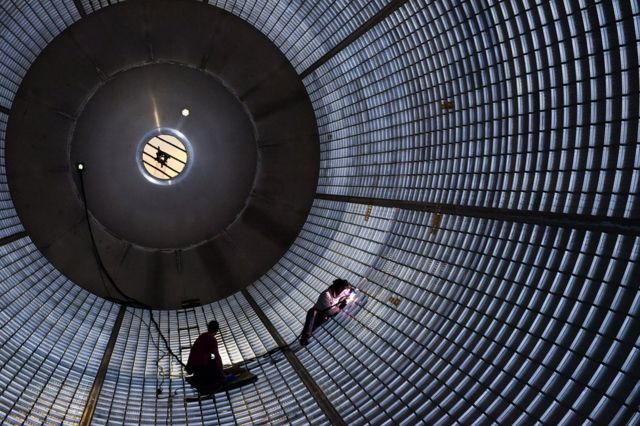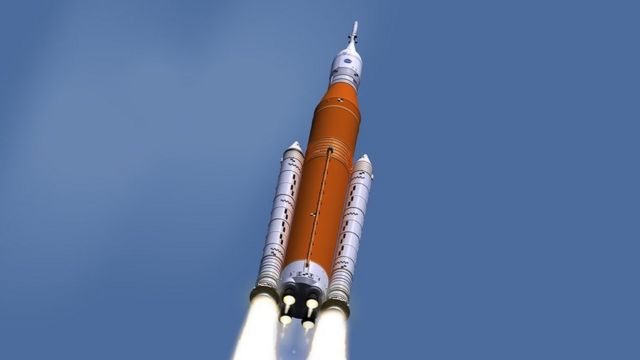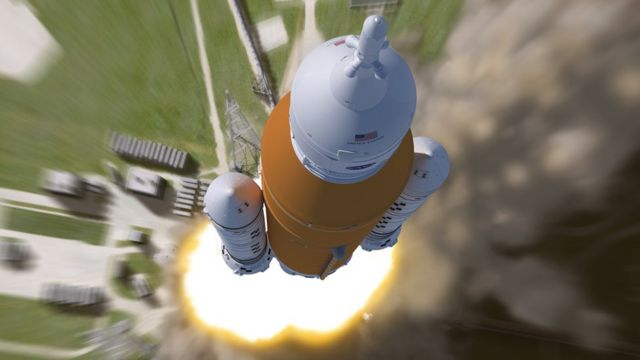All About NASA's Giant Rocket That Will Take Astronauts to the Moon and Mars
First stage SLS rocket being transported from New Orleans to Mississippi for testing
NASA is developing a huge rocket called the Space Launch System (SLS) to take astronauts to the Moon — and eventually to Mars. The SLS is the most powerful launch vehicle built since 1960 and is scheduled to debut in late 2021.
NASA plans to send a man and a woman to the lunar surface later this decade — it will be the first human landing on the natural satellite's surface since Apollo 17's departure in 1972.
For the past 20 years, astronauts have been making routine trips to the International Space Station (ISS), but the Moon is almost a thousand times farther away than the ISS. Getting astronauts there requires a much more powerful rocket.
The SLS is the modern equivalent of Saturn V, the great launcher built during the era of the Apollo spacecraft. Like Saturn, it is divided into segments, or stages, stacked on top of one another. But the new rocket also incorporates space shuttle technology.
SLS Block 1 will be 23 stories above the launch pad — making it taller than the Statue of Liberty (93 m).
"It's a really huge rocket. It's just huge," said John Shannon, vice president and program manager for SLS at Boeing, NASA's main contractor for the rocket's production. "You just haven't seen anything like it since Saturn V," Shannon told the BBC in 2019.
The rocket will launch astronauts into NASA's next generation of manned vehicles — Orion vehicles. The SLS will propel Orion at the speeds necessary to exit close-Earth orbit and travel to the moon.
how the rocket works
The SLS consists of a giant central stage flanked by two solid rocket boosters (SRBs). The core houses two large storage tanks: one for liquid hydrogen, the fuel, and one for liquid oxygen, which allows the fuel to burn. Together they are known as propellants.
At the base of the center stage are four RS-25 engines, the same ones that powered the former space shuttle launcher, retired in 2011.
Workers inside the SLS hydrogen tank perform wall maintenance
When the engine chambers are fed with liquid hydrogen and oxygen and ignited, a chemical reaction begins that produces huge amounts of energy and steam. Vapor exits the engine's nozzles at speeds of 16,000 km/h and generates propulsion—the force that pushes the rocket upward.
In addition to the power generated by the engine, SRBs side rocket boosters give extra help in escaping Earth's massive gravity force. These twin thrusters are 17 stories tall and burn 6 tons of solid propellants per second. They are responsible for 75% of the total propulsion during the first two minutes of flight.
The most powerful rocket ever?
If we use propulsion as a measure, the SLS will be the most powerful rocket ever when it flies into space in 2021. Block 1 SLS will generate 39.1 meganewtons of thrust (propulsion) at launch, 15% more than the Saturn V.
In the 1960s, the now-defunct Soviet Union (USSR) built a rocket called the N1. Its first stage would produce 45.4 meganewtons of thrust. But all four test flights failed.
A future version of SLS — called Block 2 — is expected to approach N1 propulsion levels. But a vehicle called the Starship, being developed by Elon Musk's SpaceX company, can exceed both — producing 66.7 meganewtons of thrust. This spacecraft is currently under development and there is no set date for its first flight.
Illustration of SLS during launch
How Space Shuttle Technology Was Reused
The center stage of the SLS is based on the space shuttle's foam-covered outer tank. This tank provided propellants for three RS-25 engines in the rear of the shuttle's orbiter. Solid rocket boosters perform pretty much the same function on both ships.
But SLS is very different. A number of components and structures derived from the space shuttle have undergone significant changes due to the different voltage levels achieved in the new rocket.
One example is that on the space shuttles the RS-25 engines were far from the SRBs and tilted up. In the SLS, the engines are next to the SRBs, exposed to much more tremors. Therefore, every system in the complex SLS engine section had to be rigorously tested to ensure it could withstand the vibrations.
Why SLS Was Built
In February 2010, the Obama administration canceled George W. Bush's troubled plan to return to the moon in 2020, called Constellation.
The news was unwelcome by workers in five southern states — Alabama, Florida, Louisiana, Mississippi and Texas — where NASA's manned spaceflight program generated tens of thousands of jobs.
Some lawmakers were furious. At the time, Richard Shelby, a Republican senator from Alabama, said Congress would not "sit back and watch the reckless abandon of the manned spaceflight program."
Lawmakers in the affected states then insisted on creating a single powerful rocket to replace the Constellation launchers canceled by the White House.
NASA will have spent more than $17 billion (BRL 87 billion) on SLS by the end of fiscal year 2020
The SLS design, based on NASA technical studies, was unveiled in 2011. After the rocket's development began, delays and budget overruns gave ammunition to critics, who felt NASA should work with rockets operated by commercial suppliers.
But without significant modifications, no existing thruster has enough power to send the Orion spacecraft, astronauts, and large payloads to the Moon in one flight — as the SLS would.
A recent report states that NASA will have spent more than $17 billion (R$87 billion) on SLS by the end of fiscal year 2020.
But with the rocket's development phase now complete and an evaluation program known as the Green Run successfully completed, the first SLS rocket is now at Florida's Kennedy Space Center, being prepared for its maiden flight in late 2021.
John Shannon, who has been in charge of the SLS at Boeing since 2015, said: “I believe that once the SLS is at full capacity, there will be no need for another heavy-duty vehicle like this for many years. happens more than once in the same generation."






No comments:
Post a Comment